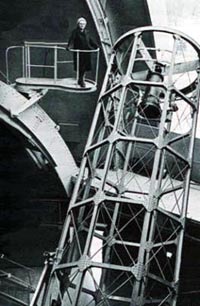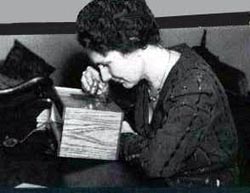 |
Helen Sawyer Hogg seen here in 1975 at the David Dunlap Observatory platform, Richmond Hill, Ontario, from which she studied the constellations over a 40-year career. [Photo, courtesy Sally MacDonald] |
In 1910, when Helen
Sawyer of Lowell, Massachusetts, was five, she saw Halley’s comet. When
she was 19 and majoring in chemistry at Mount Holyoke College, Massachusetts,
she saw a total eclipse of the sun and decided that the study of celestial
bodies was the career for her. A year later, Helen so impressed a visiting
astronomer at Mount Holyoke that she was recommended to Dr. Harlow Shapley
at the Harvard College Observatory. There she met a young Canadian, Frank
Hogg, who, in 1929, was the first student to obtain a doctorate in Astronomy
from Harvard. The following year they were married and after Helen received
her doctorate from Radcliffe in 1931, they moved to Canada where Helen
became Canada’s best-known astronomer and a much-respected worldwide authority
on globular star clusters.
 |
Helen Sawyer Hogg seen here in 1975 at the David Dunlap Observatory platform, Richmond Hill, Ontario, from which she studied the constellations over a 40-year career. [Photo, courtesy Sally MacDonald] |
For the next 20 years Helen and Frank shared their interest in astronomy. He joined the staff of the University of Toronto. When the University’s David Dunlap Observatory opened in Richmond Hill, Ontario, in 1935, Frank was employed as one of its first astronomers, and Helen worked there for a year as a volunteer before becoming a research assistant. In 1937 Frank also became assistant editor of the journal published by the Royal Astronomical Society and, in 1941, initiated and wrote a weekly article on astronomy for The Toronto Star. Helen, who joined the staff of the University of Toronto that same year, often assisted, sometimes writing The Toronto Star articles herself. In 1946, Frank was appointed head of the Department of Astronomy at the University of Toronto as well as Director of the Observatory, retaining both positions until his sudden death on New Year’s Day, 1951.
Within two weeks
of her husband’s death, Dr. Hogg took over writing the weekly articles
for The Toronto Star, an assignment she continued for the next 30
years. In 1957 she became a full professor of astronomy at the University
of Toronto. By then she had gained international fame for her study of
the globular star clusters of the Milky Way. Her particular interest was
searching for the variable stars within the clusters. These are stars that
vary their output of light over timescales that may range from a few hours
to a few years, and by measuring such changes, astronomers could establish
their age. While the reason for these differences is still not fully understood
and is a subject frequently discussed in astronomical literature, Dr. Hogg’s
own studies indicated that some stars might be 14 billion years old.
 |
Helen Hogg, viewed, circa 1939, examines a photographic plate using an eyepiece and blink box. Her many years as an astronomer at the University of Toronto made her the world’s authority on globular star clusters. [Photo, courtesy Sally MacDonald] |
Dr. Hogg not only shared her enthusiasm and vast knowledge of the universe with other astronomers worldwide but communicated her understanding of the universe to the public at large through numerous lectures and articles. In addition to her weekly Toronto Star column, she published The Stars Belong to Everyone (1976) and contributed numerous articles to the Royal Astronomical Society’s newsletter, journal, and the Society’s Observer’s Handbook, published annually. She also served as president of the Society between 1957-59 and was the first woman president of the Royal Canadian Institute, 1964-65. When the Canadian Astronomical Society was formed in 1971, she was elected its first president. She and Pauline Vanier were the first two women elected to the board of Bell Canada.
Many honours were bestowed upon Dr. Hogg. In 1949 she received the Annie J. Cannon prize from the American Astronomical Society, followed by the Rittenhouse Silver Medal of the Rittenhouse Astronomical Society, Philadelphia, in 1967. A year later she was named an Officer of the Order of Canada, and in 1976, the year she retired as an active professor at the University of Toronto, Dr. Hogg was appointed Professor Emeritus and made a Companion of the Order of Canada, an honour that only 150 Canadians can hold at any one time. In 1981, she stopped writing her weekly Toronto Star column, but her 30 years as columnist was recognized two years later when she became the first Canadian given the Klumpke-Roberts Award by the Astronomical Society of the Pacific for her work in public education. The asteroid 2917 in the solar system was named Sawyer-Hogg in her honour, and, in 1989, she, with members of her family, attended a ceremony to rename the Observatory at the National Museum of Science and Technology in Ottawa in her name.
Mel James